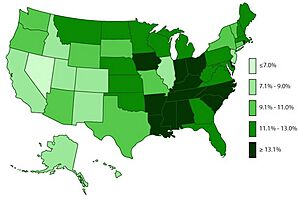ADD facts for kids
Attention-Deficit Hyperactivity Disorder, often called ADHD, is a common condition that affects how a person's brain works. It can make it harder for someone to pay attention, control their actions, and stay still. ADHD is not a choice or a sign of being lazy; it's a real difference in the brain that people are born with.
Contents
Understanding ADHD
ADHD stands for Attention-Deficit Hyperactivity Disorder. It's a neurodevelopmental condition, meaning it affects how the brain develops and functions. People with ADHD might find it challenging to focus on tasks, organize their thoughts, or wait their turn. They might also be very active or restless.
What are the Signs of ADHD?
The signs of ADHD can be different for each person, but they usually fall into three main types:
- Inattention: This means having trouble paying attention. Someone might easily get distracted, forget things often, or struggle to follow instructions. They might also have difficulty finishing tasks or organizing their schoolwork.
- Hyperactivity: This refers to being overly active. A person might fidget a lot, have trouble sitting still, or talk excessively. They might feel restless and need to move around a lot.
- Impulsivity: This involves acting without thinking. Someone might interrupt others, blurt out answers, or take risks without considering the consequences.
It's normal for all kids to show some of these behaviors sometimes. However, for someone with ADHD, these signs are more severe, happen more often, and affect their daily life at school, home, and with friends.
How is ADHD Diagnosed?
ADHD is diagnosed by doctors or mental health specialists, like psychologists. They look at a person's behavior over time and in different situations. There isn't a single test for ADHD. Instead, the specialist will:
- Talk to the person and their family about their behaviors and challenges.
- Gather information from teachers or other adults who spend time with the person.
- Use checklists or rating scales to assess symptoms.
- Rule out other possible reasons for the behaviors.
A diagnosis helps people understand their challenges and find ways to manage them.
Living with ADHD
Living with ADHD can be challenging, but many strategies and supports can help.
- Therapy: Behavioral therapy can teach people skills to manage their symptoms, like how to organize tasks, improve focus, and control impulses.
- Medication: For some people, medication can help balance brain chemicals and reduce symptoms. This is always decided by a doctor.
- Support at School: Schools can provide accommodations, such as extra time for tests, a quiet place to work, or help with organization.
- Support at Home: Creating routines, setting clear expectations, and using positive reinforcement can help at home.
With the right support, people with ADHD can learn to manage their symptoms and succeed in school, friendships, and life. Many famous and successful people have ADHD, showing that it doesn't stop you from achieving great things.
Images for kids
See also
 In Spanish: Trastorno por déficit de atención con hiperactividad para niños
In Spanish: Trastorno por déficit de atención con hiperactividad para niños




